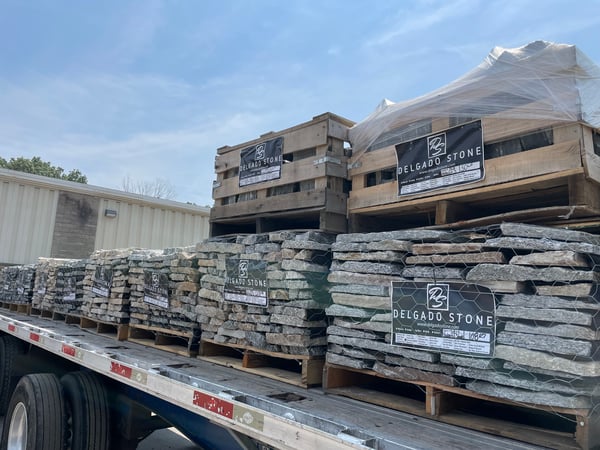Natural thinstone veneer is classified as a piece of natural stone that has a sawn back and weighs less than 15 lbs per square foot. For Delgado Stone, thinstone veneer pieces are sawn to 1" thick with a 1/4" tolerance and sawn into one of 5 patterns as well as rounds. Before this material is wrapped, labeled, and staged to be shipped, there is an extensive manufacturing process that transforms raw material into thinstone veneer involving multiple talented teams and heavy equipment.

Thinstone Veneer Pallets Loaded Onto a Truck
There are 5 major steps to the thinstone veneer process.
- Quarry/Harvesting
- The Arrival of Raw Material
- Large Splitter
- Small Splitter
- Thinstone Veneer Saws (Flats and Corners)
Quarrying/Harvesting
Quarry Blast at the Sterling Tan Quarry in Connecticut
The raw natural stone material is mainly sourced either through quarrying or by harvesting fieldstone. The quarrying technique on display above is blasting which involves strategically drilling holes into the stone and filling them with explosives to create useable material. Other techniques include diamond-wire saws, jet-burner channeling, and feather & wedge. The other popular option is harvesting which is the process of sourcing stone from open fields and then sorting it by general shape to be used in a variety of ways.
The Arrival of Raw Material
After the raw material is sourced through one of those channels it is brought to the manufacturing facility, where the material is sorted for the highest maximum yield. At this stage, the material can be allocated to landscape and saw shop products or designated to become veneer.
Raw Material Arriving at Delgado Stone from the Quarry
Large Splitter
At this point, multiple teams have already handled the material to source it and deliver it to the facility. For the first time, a member of our production team will start the shaping process. To begin to shape the large slabs into smaller cubes the material is loaded onto the large guillotine (splitter) which is called the "Big G". The Big G can apply up to 600 tons of pressure and its main purpose is to turn slabs into smaller cubes that can be handled by a team member at the next stage.
Big G Breaking Down Quarry Slabs Into Cubes
Small Splitter
The size and shape of the cubes are crucial components of the thinstone veneer process. Cubes need to be small enough that a small splitter operator can move them into place to be split but also large enough that the splitter operator can create useable material that can be cut into one of the 5 thinstone veneer patterns. Below, small splitter operator Junior is shaping material into the roughly square and rectangle pattern. While creating larger pieces to fit the specifications of the roughly square and rectangle pattern, the by-product is saved to be used for other patterns like ashlar and ledge.
Small Splitter Operator Shaping Veneer
Thinstone Veneer Saws
After the small splitter operator has shaped the piece into of the 5 patterns it goes to the thinstone saw which will saw off one face of the piece to approx. 1" thick with a 1/4" tolerance. Each thinstone saw has a conveyor operator who loads the shaped material onto the saw and a palletizer who palletizes the sawn thinstone pieces. The palletizers are tasked with creating layer after layer of stone puzzles that are unique every time. The palletizer will also shape the material for the final time making sure it fits the pattern specifications before being placed on the pallet.
Palletizing CT Blend Mosaic Thinstone Veneer
After this stage the material is ready to ship, it will be wrapped, labeled, and loaded on a truck as it is in the picture at the top of this article.
Throughout the extensive thinstone veneer process it is crucial that all of the team members at the different stages are aligned and aware of what the end product will be. Being aligned helps everyone create a higher quality, consistent piece of thinstone veneer every time. Throughout the 6 stages of the process from quarrying/harvesting material through wrapping, labeling, staging, and shipping the end product, there are countless individuals that handle the stone. For more information on the specifications of the thinstone veneer flats and corners, download the veneer spec guide.




-2.png?width=150&height=150&name=Untitled%20design%20(2)-2.png)
COMMENTS